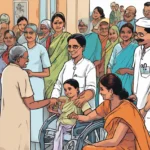Introduction
With over 50% of its population under the age of 30, Uttar Pradesh (UP) is experiencing a demographic shift that places youth at the center of its political narrative. As India’s most populous state, UP’s young voters are not just a significant demographic—they are a powerful force that can influence election outcomes and reshape governance priorities. Political parties are now adopting new strategies to engage this dynamic segment, but are they effectively addressing the aspirations of this generation?
Why Youth Matter in UP Politics
1. Sheer Numbers
- Key Statistic:
- UP is home to more than 90 million young voters, making them a decisive bloc in any election.
- In the 2019 General Elections, youth turnout in UP significantly influenced the victory margins in multiple constituencies.
(Source: Election Commission of India)
2. The Demand for Change
Young voters in UP are more focused on issues like education, employment, and digital connectivity rather than traditional caste and religious narratives.
- Key Concerns:
- Unemployment remains a pressing issue, with over 8.9% youth unemployment rate reported in 2022.
- Access to quality education and vocational training continues to lag in rural areas.
(Source: National Sample Survey Office (NSSO))
Strategies to Engage Young Voters
1. Focus on Employment and Skill Development
- Current Initiatives:
- Programs like the UP Skill Development Mission (UPSDM) aim to train youth in high-demand sectors like IT, logistics, and advanced manufacturing.
- Start-up incubators in Noida and Lucknow are promoting entrepreneurship.
- Impact:
- Over 1 million youth have been trained, but aligning these programs with industry needs remains a challenge.
(Source: UPSDM)
2. Digital Campaigning
UP’s youth are highly active on social media platforms, making digital outreach critical for political engagement.
- Examples:
- Parties like the BJP and SP have extensively used WhatsApp groups, Twitter, and Instagram to connect with young voters.
- Interactive town halls and online Q&A sessions are gaining traction.
(Source: Digital India Initiative)
3. Youth-Focused Policies
- Popular Promises:
- Free laptops, scholarships, and subsidies for higher education are key incentives targeted at young voters.
- Job guarantees under schemes like Mukhya Mantri Yuva Swarozgar Yojana aim to address employment concerns.
Challenges in Engaging UP’s Youth
1. Urban-Rural Divide
- Urban youth have better access to education and job opportunities compared to their rural counterparts.
- Bridging this gap is essential to ensure equal political participation.
2. Disillusionment with Politics
- Many young voters feel disconnected from traditional political narratives, citing unfulfilled promises and lack of transparency.
3. Polarization Risks
- Political parties risk alienating young voters by focusing too heavily on caste and religious polarization instead of developmental agendas.
The Path Forward
1. Strengthening Vocational Education
- Expanding skill-training programs in backward regions like Bundelkhand and Purvanchal can create a more employable workforce.
2. Inclusive Policy Formulation
- Actively involving youth in policy-making through consultative platforms can address their specific concerns.
3. Promoting Civic Engagement
- Encouraging youth participation in local governance and community initiatives can foster a sense of political ownership.
Expert Opinions
- Political Analyst’s View:
- “Young voters in UP are more issues-driven than ever. Parties that address their aspirations with actionable policies stand to gain significantly.”
- Youth Leader’s Insight:
- “UP’s youth are eager for opportunities. Engagement must go beyond rhetoric to focus on tangible solutions in education and employment.”
(Source: UP Government Reports)
Conclusion
The youth of Uttar Pradesh are reshaping the state’s political landscape, demanding accountability, and prioritizing development over traditional vote-bank politics. Political parties must recognize this shift and actively address the aspirations of this dynamic demographic. By focusing on education, employment, and digital outreach, UP’s youth can be transformed from passive voters to active participants in governance, driving the state’s political and economic growth for decades to come.













